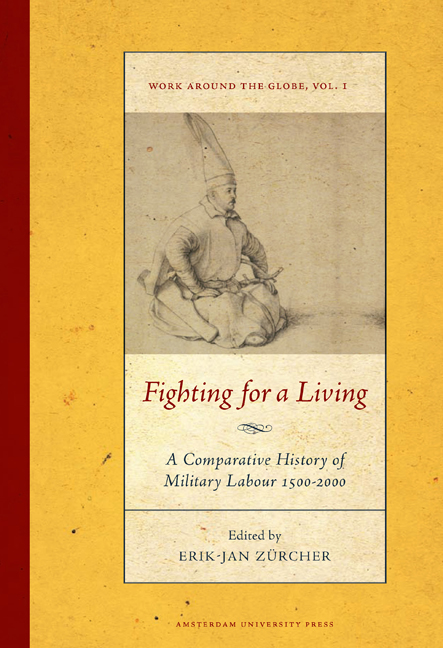Book contents
- Frontmatter
- Dedication
- Contents
- Preface
- Introduction: Understanding Changes in Military Recruitment and Employment Worldwide
- Military Labor in China, c. 1500
- From the Mamluks to the Mansabdars: A Social History of Military Service in South Asia, c. 1500 to c. 1650
- On the Ottoman Janissaries (Fourteenth-nineteenth Centuries)
- Soldiers in Western Europe, c. 1500-17901
- The Scottish Mercenary as a Migrant Labourer in Europe, 1550-1650
- Change and Continuity in Mercenary Armies: Central Europe, 1650-1750
- Peasants Fighting for a Living in Early Modern North India
- “True to Their Salt”: Mechanisms for Recruiting and Managing Military Labour in the Army of the East India Company During the Carnatic Wars in India
- “The Scum of Every County, the Refuse of Mankind”: Recruiting the British Army in the Eighteenth Century
- Mobilization of Warrior Populations in the Ottoman Context, 1750-1850
- Military Employment in Qing Dynasty China
- Military Service and the Russian Social Order, 1649-1861
- The French army, 1789-1914: Volunteers, Pressed Soldiers, and Conscripts
- The Dutch Army in Transition: From All-volunteer Force to Cadre-militia Army, 1795-1830
- The Draft and Draftees in Italy, 1861-1914
- Nation-building, War Experiences, and European Models: The Rejection of Conscription in Britain
- Mobilizing Military Labor in the Age of Total War: Ottoman Conscription Before and During the Great War
- Soldiering as Work: The All-volunteer Force in the United States
- Private Contractors in War From the 1990s to the Present: A Review Essay
- Collective Bibliography
- Notes on Contributors
Change and Continuity in Mercenary Armies: Central Europe, 1650-1750
Published online by Cambridge University Press: 12 December 2020
- Frontmatter
- Dedication
- Contents
- Preface
- Introduction: Understanding Changes in Military Recruitment and Employment Worldwide
- Military Labor in China, c. 1500
- From the Mamluks to the Mansabdars: A Social History of Military Service in South Asia, c. 1500 to c. 1650
- On the Ottoman Janissaries (Fourteenth-nineteenth Centuries)
- Soldiers in Western Europe, c. 1500-17901
- The Scottish Mercenary as a Migrant Labourer in Europe, 1550-1650
- Change and Continuity in Mercenary Armies: Central Europe, 1650-1750
- Peasants Fighting for a Living in Early Modern North India
- “True to Their Salt”: Mechanisms for Recruiting and Managing Military Labour in the Army of the East India Company During the Carnatic Wars in India
- “The Scum of Every County, the Refuse of Mankind”: Recruiting the British Army in the Eighteenth Century
- Mobilization of Warrior Populations in the Ottoman Context, 1750-1850
- Military Employment in Qing Dynasty China
- Military Service and the Russian Social Order, 1649-1861
- The French army, 1789-1914: Volunteers, Pressed Soldiers, and Conscripts
- The Dutch Army in Transition: From All-volunteer Force to Cadre-militia Army, 1795-1830
- The Draft and Draftees in Italy, 1861-1914
- Nation-building, War Experiences, and European Models: The Rejection of Conscription in Britain
- Mobilizing Military Labor in the Age of Total War: Ottoman Conscription Before and During the Great War
- Soldiering as Work: The All-volunteer Force in the United States
- Private Contractors in War From the 1990s to the Present: A Review Essay
- Collective Bibliography
- Notes on Contributors
Summary
The second half of the seventeenth century saw significant changes in the structures of the most important military organizations on the European continent. Collectively, these changes are commonly labelled as the introduction of standing armies. These changes certainly had a deep impact on the terms as well as the conditions of military labour. However, it needs to be discussed whether these developments should be understood as a categorical transformation, putting military labour in a typological framework of its own, or whether it would be more appropriate to stress the aspects of continuity and to embed these aspects of change in a more evolutionary interpretative framework. This chapter will argue that several changes of particular importance altered the face of military labour so that it hardly could be equated with the classical era of mercenaries in the sixteenth and early seventeenth centuries. Nevertheless, the components were still tied to various traditions and did not constitute a completely innovative system that could be compared with the later transformations initiated by the French Revolution – though even the revolutionaries, of course, could not avoid being based on existing forms of military institutions.
In accordance with the objectives of the Fighting for a Living project, this chapter will initially outline the current state of research. Particular attention will be given to the modes of recruitment, which not only can be considered crucial criteria for categorizing the type of military labour but which also developed significant variations during the era under discussion here. The second part of the chapter will discuss and reassess the empirical findings in the framework of some more general categories related to the typology and dynamics of military labour.
The most obvious expression of these changes was not inevitably connected with the principles of standing armies and consisted simply of significant growth in the size of many armies. At the forefront of these developments was the French army, which established new levels for the military strength of a leading power within the European concert. Some figures will illustrate the extent of growth. Of course, it is impossible to determine exact numbers; due to the lack of sources as well as discrepancies between normative prescriptions, a limited range of records, and the presumed reality, the numbers are the result of more or less rough estimates and ongoing discussions.
- Type
- Chapter
- Information
- Fighting for a LivingA Comparative Study of Military Labour 1500–2000, pp. 201 - 242Publisher: Amsterdam University PressPrint publication year: 2013
- 1
- Cited by

